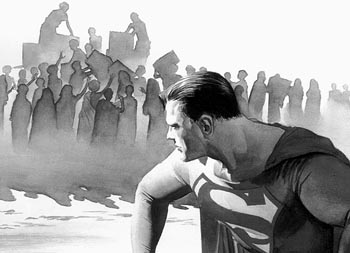![[Metroactive Books]](/books/gifs/books468.gif)
[ Books Index | Metro | Metroactive Central | Archives ]
Square Is Beautiful
 The Hunger Artist: Even Superman's efforts to ease the world's suffering fall short in Alex Ross' superb 'Superman: Peace on Earth.' Cartoonist Alex Ross revives the moral authority of the Man of Steel ALL OF THE WORST tendencies in comic books--the sloppiness, the violence, the cheapness--are opposed by the work of Alex Ross. His art brings back a sense of the tangibility of cartoon characters that readers may not have felt since childhood. Ross is probably the hardest-working man in comics, and he's quickly made it to the top of his profession in both awards and recognition. But in my opinion, Ross hasn't had writers who matched the gravitas of his images. In Superman: Peace on Earth (DC; $9.95), Ross' images are paired with the words and story of Paul Dini. Dini, who has worked on the animated The Adventures of Batman, one of the smartest and most entertaining TV shows of the '90s, has spent as much time mulling over the meaning and purpose of pulp superheroes--what's worthwhile about them, in short--as Ross has depicting them. "It was magical," Ross says by phone from his home in suburban Chicago. "Paul and I are as much of one mind as any two people could be. Sometimes the work had an almost stream-of-consciousness quality." Ross' Superman looks the way TV's George Reeves played him in the 1950s. He's a little wounded and tired, with a bit of a dewlap, a bull neck and age lines on his face. "That's supposed to be my younger Superman!" Ross protests. In Ross' popular comic-book miniseries, Kingdom Come, he painted the Kryptonian as an even older, grayer man. "In Peace on Earth, Superman is as young as I'm going to let him be," Ross says. "There's too much fascination with youth in this country. Like it or not, Superman has the weight of age." Superman: Peace on Earth is more than just a holiday tie-in. In this downright touching adventure, told in the first person, Superman makes a holiday decision to feed the entire world for one day. He learns, however, that the logistics of the trip are too much for one man, even for Superman. Food riots, dictatorships and xenophobia hamper a mission that ends "incomplete and in failure." The hopelessness familiar to anyone seeking to change the world overwhelms Superman. He learns the enormity of the task of fixing the world--and remembers that the smallest gestures are important places to begin. WHAT DOES Superman mean to Ross? "He's basically a metaphor," the artist says, "a metaphor that's just as useful in a work of fiction as if he really existed. He serves no greater purpose than [his ability] to inspire others. "Superman can remind us of certain ethics and moral choices. A lot of my personal makeup, my belief systems, right and wrong, were based in Superman. A lot of what he communicated is lacking in current comics. I realize that comics have always been about commerce and are slanted toward an aesthetic of cheap thrills so that they can compete with more aggressive forms of entertainment. What I want to bring back is a sense of morality to comics." So the Christian imagery in Ross' comics is deliberate. For example, the page showing Superman approaching the Christ of the Andes in Rio de Janiero, as he descends to help the favella dwellers? "Absolutely," Ross says. "There's a great aspect of Christian myth in Superman--only an aspect of that myth, of course, but it's the same aspect that's very strong in any kind of messiah story. A messiah comes to inspire us. Peace on Earth explains that by no means should Superman have the authority to save us from ourselves. He's there to try, but never to succeed. We could only benefit from the example of his never-ending battle." Yet Ross and Dini have kept the book outside of religion, organized or disorganized. "The word 'Christmas' is never even voiced here," Ross says. "The more Peace on Earth reflects a multicultural, multibelief system, the greater effect the book will have." The album-sized Superman: Peace on Earth occupies the middle ground between children's book and comic book. "We were trying to make it something that can be brought to your children without shame," Ross claims. "Making the language simple enough is a huge endeavor, but conquerable. No one in the comics business needs to throw up their hands about reaching children." Ross came to comic art later in life, having worked as a story-board artist for a Chicago ad agency, mostly "learning how to draw realistic forms quickly and on demand." Ross remembers his own childhood fondness for the medium. "I have the same expectations and needs as any other fan," he says. "In my art, I try to create a public for what I'd like to see." Does Peace on Earth oversimplify the problem of world hunger? Of course it does--what doesn't? But the comic book also stirs feelings that lie buried underneath a crust of despair, reminding readers of the hopefulness that images of Superman once inspired. Here's a comic-book artist using his power fantasies for good instead of evil. Superman: Peace on Earth is the mainstream comic at its best.
Paul Dini and Alex Ross will appear Dec. 19, 4-7pm, at Lee's Comics, 3783 El Camino Real, Palo Alto. (650/493-3957) [ San Jose | Metroactive Central | Archives ]
|
From the December 3-9, 1998 issue of Metro.
Copyright © Metro Publishing Inc. Maintained by Boulevards New Media.